Introduction: A Northern Star
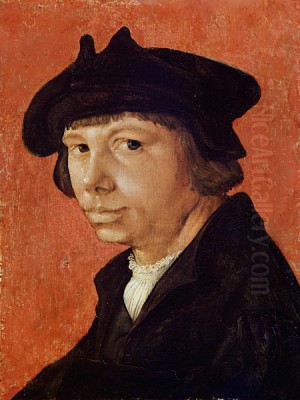
Lucas van Leyden stands as one of the towering figures of the Northern Renaissance, a Dutch artist whose brilliance shone brightly, albeit briefly, during the first decades of the 16th century. Born in the historic city of Leiden in the Netherlands, he emerged as a multifaceted talent – a highly accomplished painter, a masterful engraver, and a skilled draftsman. His reputation, primarily built upon his exceptionally fine and innovative prints, spread rapidly across Europe during his lifetime, placing him among the most respected artists of his generation alongside contemporaries like Albrecht Dürer. Lucas was not merely a technician; he was an innovator, blending the rich, detailed traditions of Northern European art with the emerging ideals and compositional strategies of the Italian Renaissance, creating a unique artistic language that profoundly influenced subsequent generations. His exploration of diverse subjects, from profound religious narratives to intimate scenes of daily life, marked him as a versatile and observant chronicler of his time.
Early Life and Precocius Talent in Leiden
The precise year of Lucas van Leyden's birth remains a subject of some scholarly debate. While the influential early art historian Karel van Mander suggested 1494, possibly in May or June, some modern scholars lean towards an earlier date, perhaps 1489. However, the 1494 date remains the most commonly accepted. What is undisputed is his birthplace: the prosperous cloth-manufacturing city of Leiden in the County of Holland. Artistry ran in his family; his father, Huygh Jacobsz, was a painter, likely providing Lucas with his initial instruction in the craft. It quickly became apparent that Lucas possessed an extraordinary, almost prodigious, talent.
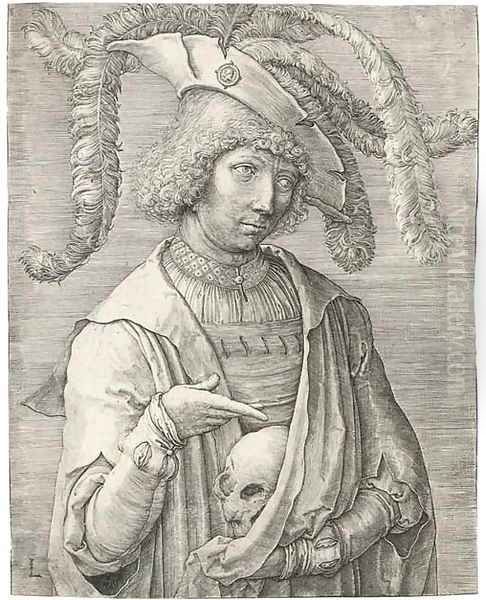
Legends recorded by Van Mander, though perhaps embellished, speak to his early aptitude. It is said he created his first engraving, Mohammed and the Murdered Monk Sergius, at the remarkably young age of 14 (or possibly even earlier if the 1489 birth year is correct). Another tale recounts him selling a painting, The History of St. Hubert, at the age of 12. While the exact ages might be legendary, they underscore the consensus that Lucas matured artistically at an astonishingly rapid pace. Beyond his father's workshop, his formal training is believed to have taken place under Cornelis Engelbrechtsz, a leading painter in Leiden at the time. Engelbrechtsz's workshop would have exposed Lucas to the prevailing late Gothic styles, characterized by expressive figures, detailed settings, and often dramatic religious themes, providing a solid foundation upon which Lucas would build his own distinct artistic vision.
The Master Printmaker Emerges
While Lucas van Leyden achieved recognition as a painter, his most significant and enduring contribution to art history lies in his work as a printmaker. He mastered the techniques of engraving, etching, and woodcut with exceptional skill and sensitivity. Engraving, in particular, became his forte. Working with a burin on a copper plate, he achieved levels of detail, tonal subtlety, and atmospheric effect that were groundbreaking for his time. His early prints, produced while he was still a teenager, already demonstrated remarkable technical control and compositional ambition.
His prints quickly gained widespread popularity, not just in the Netherlands but across Europe. The portability and reproducibility of prints allowed his work to circulate far more widely than paintings could, establishing his international reputation. He explored a vast range of subjects in his prints, mirroring the diversity seen in his paintings but often with even greater complexity and narrative depth. Religious scenes from both the Old and New Testaments were frequent subjects, allowing him to delve into complex theological narratives and human emotions. He also produced allegorical prints, mythological subjects, and, significantly, scenes depicting contemporary life, including peasants, soldiers, and gamesters. This breadth of subject matter, combined with his technical virtuosity, made his prints highly sought after by collectors and fellow artists alike.
Artistic Style: A Synthesis of North and South
Lucas van Leyden's artistic style is characterized by a fascinating synthesis of Northern European traditions and Italian Renaissance influences. From his Northern heritage, particularly the legacy of artists like Jan van Eyck and Rogier van der Weyden, he inherited a meticulous attention to detail, a love for rich textures, and a capacity for conveying deep emotion through gesture and facial expression. His figures, even in crowded scenes, often possess a distinct psychological presence. He excelled at rendering fabrics, surfaces, and the particularities of the natural world with convincing realism.
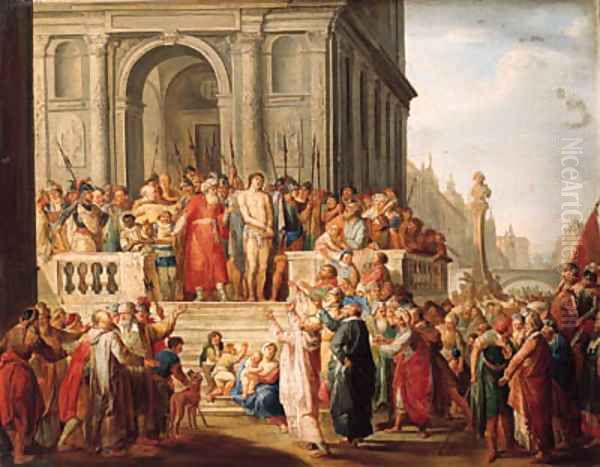
However, Lucas was also keenly aware of artistic developments south of the Alps. While it is uncertain if he ever travelled to Italy himself, Italian Renaissance ideas reached him through various channels, most notably through the circulation of prints, particularly those by Marcantonio Raimondi who reproduced designs by Raphael, and through contact with artists who had travelled, such as Jan Gossaert and Albrecht Dürer. From Italy, Lucas absorbed concepts of classical proportion, more dynamic figure arrangements, and a greater emphasis on anatomical accuracy. He experimented with perspective and spatial depth, often creating complex, receding landscapes or architectural settings for his narratives. His unique achievement was not simply to copy Italian models, but to integrate these elements seamlessly with his innate Northern sensibility, creating works that felt both innovative and deeply rooted in his own cultural context. His mastery of light and shadow, particularly evident in the subtle tonal gradations of his engravings, was crucial in achieving atmospheric perspective and unifying his often complex compositions.
Landmark Engravings and Woodcuts
Lucas van Leyden's output as a printmaker was prolific, encompassing over 200 known engravings, etchings, and woodcuts. Several stand out as landmarks of the medium and encapsulate his artistic strengths.
The Milkmaid (1510): An early but remarkably assured engraving, this work is often cited as a precursor to 17th-century Dutch genre scenes. It depicts a simple rural scene with a cow, a milkmaid, and a herdsman, rendered with unsentimental realism and a fine sense of atmospheric light. It showcases his early interest in everyday subjects alongside traditional religious themes.
Ecce Homo (1510): This large, ambitious engraving demonstrates Lucas's ability to handle complex, multi-figure compositions. Depicting Christ presented to the crowd, the scene is set within an elaborate architectural space filled with a diverse array of figures. The technical skill in rendering the crowd, the architecture, and the dramatic interplay of light and shadow is exceptional for an artist so young.
The Dance of Mary Magdalene (c. 1519): Sometimes interpreted as depicting the pleasures of the world that Mary Magdalene renounced, this engraving is notable for its dynamic composition, elegant figures, and detailed landscape background. It reflects a growing engagement with Renaissance ideals of beauty and movement, possibly influenced by his knowledge of Italian art and perhaps Dürer.
The Passion Series (various dates): Lucas created several series depicting the Passion of Christ, both in engraving and woodcut. These works allowed him to explore the narrative sequence and emotional range of the story, from the Last Supper to the Crucifixion and Resurrection, showcasing his dramatic storytelling abilities. The round Passion series (1509) is particularly noteworthy for its innovative format and intense focus.
Virgil in the Basket (c. 1525): This woodcut illustrates a popular medieval cautionary tale about the humiliation of the Roman poet Virgil at the hands of the emperor's daughter. Lucas renders the scene with narrative clarity and a touch of humour, placing the unfortunate poet, suspended in a basket, within a detailed cityscape. It highlights his skill in the woodcut medium and his engagement with popular literature.
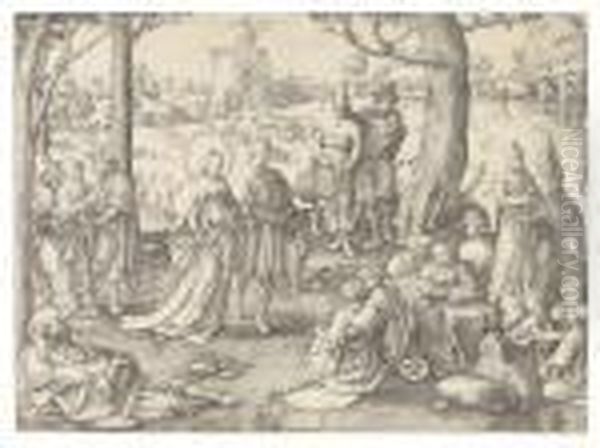
Mars, Venus, and Cupid (1530): A later engraving showing his continued engagement with classical themes and Italianate figure styles. The rendering of the nude forms demonstrates his understanding of anatomy, likely influenced by prints after Italian masters.
These examples represent only a fraction of his graphic oeuvre, which consistently displays technical brilliance, compositional ingenuity, and a keen observation of humanity and the world.
Lucas van Leyden the Painter
Although fewer paintings by Lucas van Leyden survive compared to his prints, they confirm his status as a major artist in this medium as well. His approach to painting shared many characteristics with his printmaking: complex compositions, attention to detail, expressive figures, and a blend of Northern and Italianate elements. His use of colour was often sophisticated, employing both rich, deep tones and more subtle, atmospheric palettes.
His most celebrated painting is undoubtedly the Last Judgment Triptych (c. 1526-1527). Commissioned for the Leiden Town Hall (Stadhuis) and now housed in the Museum De Lakenhal in Leiden, this large-scale work is a monumental achievement. The central panel depicts Christ presiding over the resurrection of the dead, with angels and demons directing souls towards Heaven (left wing) or Hell (right wing). The painting is remarkable for its vast, panoramic landscape, its multitude of figures rendered with anatomical care, and its dramatic depiction of divine judgment. It clearly shows Lucas engaging with the grand traditions of Netherlandish altarpiece painting, established by artists like Hieronymus Bosch and Rogier van der Weyden, while incorporating Renaissance principles of composition and figure representation.
Other notable paintings include:
The Card Players (c. 1517-1520): Similar to his print The Chess Players, this painting delves into the world of genre scenes. It depicts a group engaged in a game of cards, capturing their varied expressions and interactions with psychological insight. The rich fabrics and detailed setting showcase his skill in rendering textures.
Moses Striking the Rock (c. 1527): This painting tackles a complex Old Testament narrative, depicting Moses providing water for the Israelites in the desert. While sometimes criticized for a somewhat dispersed composition, it demonstrates his ability to handle large-scale historical subjects and integrate numerous figures within a landscape setting.
Potiphar's Wife Accusing Joseph (c. 1512): An earlier work showing his engagement with biblical narrative and dramatic human interaction.
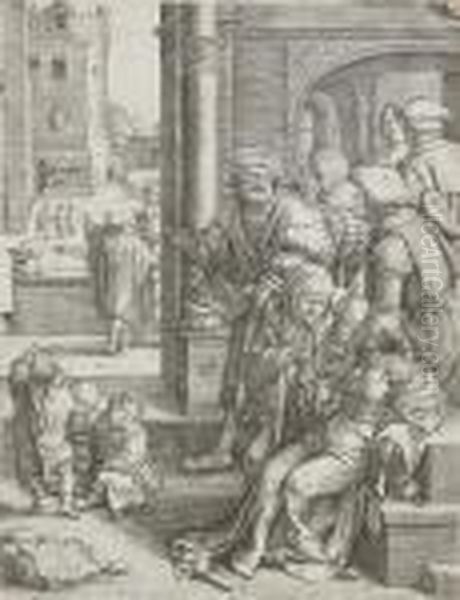
The surviving paintings confirm Lucas's versatility and his ambition to excel in the most prestigious artistic medium of his time. They complement his prints, offering insights into his handling of colour and larger formats, and solidify his position as a leading figure in Netherlandish painting during the early 16th century.
Encounters and Influences: Dürer, Gossaert, and Italy
The artistic landscape of the early 16th century was one of increasing interaction and exchange. Lucas van Leyden was part of this dynamic environment. His most famous encounter was with the German master Albrecht Dürer. In 1521, during Dürer's journey through the Netherlands, the two artists met in Antwerp. Dürer recorded the meeting in his diary, expressing admiration for the younger artist. He noted, "I was invited to dinner by Master Lucas, who engraves in copper; he is a little man, born in Leiden in Holland." They exchanged prints, a common practice among artists, signifying mutual respect. Dürer also drew a portrait of Lucas in silverpoint, a tangible record of their meeting (now in the Musée des Beaux-Arts, Lille). This encounter was significant; Dürer was the preeminent figure in Northern European art, and his recognition of Lucas affirmed the Leiden master's status. The exchange likely stimulated both artists, with Lucas absorbing aspects of Dürer's powerful graphic style and perhaps Dürer appreciating Lucas's subtle atmospheric effects.
Lucas also associated with other prominent artists. He is known to have travelled in 1527 through Zeeland, Flanders, and Brabant in the company of Jan Gossaert (also known as Mabuse). Gossaert was one of the first Netherlandish artists to travel to Italy (in 1508-1509) and actively incorporate Italian Renaissance motifs and classical themes into his work. Travelling with Gossaert would have provided Lucas with further exposure to Italianate ideas and perhaps firsthand accounts of the art scene in Rome and Florence.
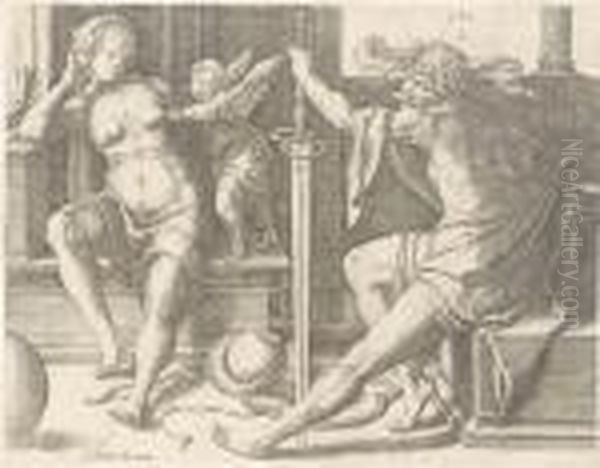
While direct Italian influence is evident, particularly in his later works showing more classically proportioned figures and mythological subjects, it was likely absorbed primarily through prints. Engravings by Marcantonio Raimondi, disseminating the designs of Raphael and other High Renaissance masters, circulated widely in the North. Lucas would certainly have studied these, adapting elements that suited his own artistic temperament. He remained, however, fundamentally a Northern artist, never fully adopting the idealized forms of the Italian High Renaissance in the way some of his contemporaries, like Jan van Scorel or Maerten van Heemskerck, later would. His art always retained a strong connection to observed reality and the expressive traditions of his homeland. Other contemporaries whose work Lucas would likely have known include the Antwerp masters Quentin Matsys and Joachim Patinir, the latter a pioneer of landscape painting.
Pioneering Genre Scenes
One of Lucas van Leyden's significant contributions was his early exploration of genre scenes – depictions of everyday life and ordinary people. While religious and historical subjects dominated high art, Lucas showed a marked interest in capturing scenes of peasants, gamblers, musicians, and market life. Works like the engraving The Milkmaid (1510), the painting The Card Players (c. 1517-1520), and the engraving The Chess Players (c. 1508) are prime examples.
In these works, he moved beyond simple illustration, often imbuing the scenes with subtle narrative or moral undertones, and always observing human behaviour with a keen eye. The Chess Players, for instance, is more than just a depiction of a game; it's a study of concentration, strategy, and social interaction within a specific setting. This focus on contemporary life and common folk, treated with the same artistic seriousness as biblical narratives, was relatively novel for its time. It laid important groundwork for the flourishing of genre painting that would become a hallmark of the Dutch Golden Age in the 17th century, famously practiced by artists like Jan Steen, Adriaen van Ostade, and even finding echoes in the work of Rembrandt van Rijn. Lucas's genre works helped to legitimize these subjects within the hierarchy of art, demonstrating their potential for artistic exploration and psychological insight. He can be seen, alongside artists like Quentin Matsys, as a key figure in the transition towards a broader range of subject matter in Northern European art, anticipating the later achievements of Pieter Bruegel the Elder.
Later Life, Travels, and Untimely Death
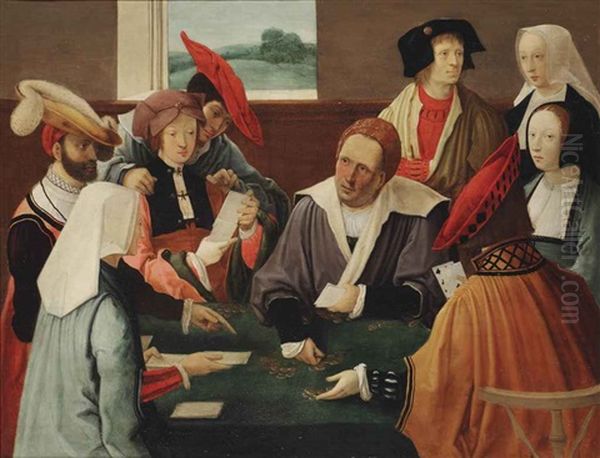
Beyond his artistic endeavors, Lucas appears to have been a respected member of Leiden society. Records suggest he married Elisabeth van Boschuyzen, the daughter of a local patrician family, further integrating him into the city's elite. He participated in civic life, possibly serving in the local militia or holding minor administrative roles, typical for a man of his standing. His travels, like the journey with Jan Gossaert in 1527, suggest an artist connected to the wider artistic community and eager to experience different regions and perhaps seek patronage or inspiration. Van Mander describes this journey as a rather grand affair, hinting at Lucas's prosperity.
However, Lucas van Leyden's flourishing career was cut tragically short. According to Van Mander, he suffered from a prolonged illness, believed to have been tuberculosis, which afflicted him for the last six years of his life. Despite his declining health, he reportedly continued to work, even drawing and engraving while confined to his bed. He died on August 8, 1533, likely only 39 years old (if born in 1494). His early death was a significant loss to the art world, silencing one of its most innovative voices at a time when he was arguably reaching the peak of his powers. His relatively short lifespan makes his prolific output and the consistent quality of his work all the more remarkable.
Legacy and Enduring Influence
Lucas van Leyden's death did not diminish his influence. His prints, already widely collected during his lifetime, continued to circulate and inspire artists for generations. His technical mastery of engraving set a high standard, influencing later virtuoso printmakers of the Dutch Golden Age, such as Hendrick Goltzius and Jacques de Gheyn II. Rembrandt, in particular, was a known admirer and collector of Lucas's prints; echoes of Lucas's dramatic lighting, expressive figures, and interest in everyday life can be discerned in Rembrandt's own graphic work and paintings.
His pioneering role in genre subjects helped pave the way for the great flourishing of that field in the 17th century. His ability to blend Northern detail with Italianate composition provided a model for artists navigating the complex cultural exchanges of the Renaissance and Reformation periods. While his paintings were less accessible than his prints, works like the Last Judgment Triptych remained influential benchmarks for large-scale narrative painting in the Netherlands. Artists like Dirk Vellert and Frans Crabbe van Espleghem show direct engagement with his style.
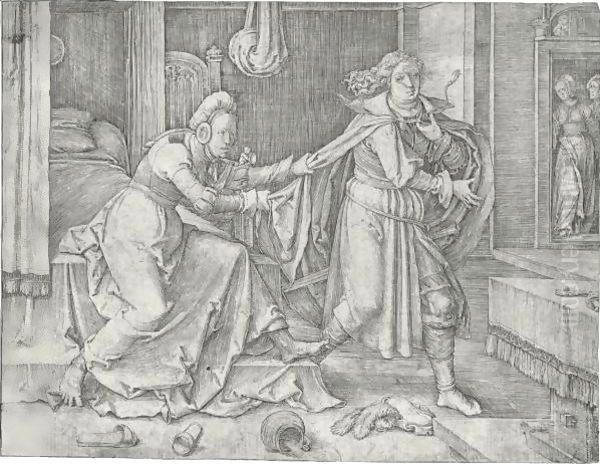
Art historians regard Lucas van Leyden as the most important Dutch artist of the early 16th century and one of the greatest printmakers in history. His work forms a crucial link between the late Gothic tradition and the emerging Renaissance sensibility in Northern Europe. He demonstrated that profound artistry could be found not only in grand religious commissions but also in the intimate medium of the print and in the observation of everyday life. His technical innovations, thematic breadth, and unique stylistic synthesis secured his place as a foundational figure in the history of Dutch art.
Conclusion: A Master of Line and Life
Lucas van Leyden remains a pivotal figure in the Northern Renaissance, an artist whose technical brilliance was matched by his innovative spirit. As a printmaker, he pushed the boundaries of engraving and woodcut, creating images of remarkable subtlety, complexity, and psychological depth that captivated audiences across Europe. As a painter, he produced works of monumental scale and intimate observation, demonstrating his versatility and ambition. He skillfully navigated the artistic currents of his time, forging a unique style that integrated the meticulous realism of the North with the compositional dynamism of the Italian Renaissance. His exploration of genre scenes opened new avenues for artistic expression, anticipating the later triumphs of Dutch Golden Age painting. Though his life was cut short, Lucas van Leyden's legacy endured through his widely disseminated prints, influencing generations of artists, including the great Rembrandt, and securing his reputation as a true master of line, light, and the depiction of human life in all its facets.